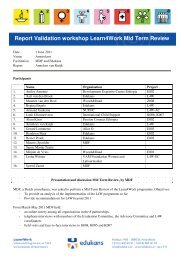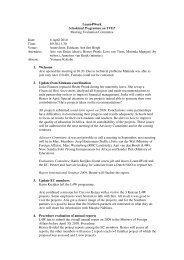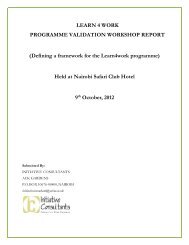Non â Formal TVET Mapping Survey Supported by Edukans ...
Non â Formal TVET Mapping Survey Supported by Edukans ...
Non â Formal TVET Mapping Survey Supported by Edukans ...
Create successful ePaper yourself
Turn your PDF publications into a flip-book with our unique Google optimized e-Paper software.
<strong>Non</strong> – <strong>Formal</strong> <strong>TVET</strong> <strong>Mapping</strong> <strong>Survey</strong> The case of Amhara, Oromia and Addis Ababa<br />
researchers had to analyze and interpret their data. According to the agreement reached<br />
each group came up with a regional report.<br />
It was the duty of the lead researcher to prepare the national report based on the three<br />
reports and information gathered from documents. In this exercise the lead researcher had<br />
to further analyze the data and produce the final document that would be presented in a<br />
workshop. In the process there was a lot of consultation with researchers and EECE staff.<br />
CHAPTER THREE<br />
3. Review of literature<br />
This unit provides the efforts made to assess experiences in terms of: policy and strategy,<br />
organization, target group, selection criteria, types of training given, curriculum, duration<br />
and results in the provision of <strong>Non</strong> <strong>Formal</strong> <strong>TVET</strong>. Some of the local and other countries<br />
experiences are documented in the following few pages. Undoubtedly there is a strong<br />
political will in support of the provision of quality formal and <strong>Non</strong>-formal <strong>TVET</strong> to a<br />
wide range of beneficiaries. The National Education and training policy and National<br />
Technical and Vocational Education and Training (<strong>TVET</strong>) strategies issued in 2002 and<br />
the revised one in 2006 pave the way for developing and implementing quality and<br />
relevant <strong>TVET</strong> programs. The Education and Training Policy, and the strategies<br />
developed to implement them are made highly interrelated to all the National Policy<br />
statement and strategies. All the National Development Policy Framework (NDPF),<br />
PASDEP and the MDGs support the provision of quality and <strong>Non</strong>-<strong>Formal</strong> <strong>TVET</strong> to all<br />
those who need to improve their livelihood. All the national policy documents capitalize<br />
on the need for fighting and eradicating poverty within the shortest possible time.<br />
3.1. The PASDEP<br />
The Plan for Accelerated and Sustainable Development to End Poverty (PASDEP) is a<br />
five-year plan of Ethiopia’s ten years MDGs (2005/06-2009/10). One of the three<br />
objectives of PASDEP is stated as “increase per capital income of citizens so that it<br />
reaches at the level of those in middle income countries”. As well known the portion of<br />
the population living under poverty line is estimated to in between 40% and 45%. This<br />
objective includes all the poor and the jobless who could have the capacity to work but<br />
not yet given the opportunity. The five pillar Strategies of the PASDEP: roads to get out<br />
of poverty are:<br />
Building inclusive implementation capacity;<br />
Massive push to Accelerate growth;<br />
Addressing the population challenge;<br />
Unleashing potentials of the Ethiopian women;<br />
Strengthen the infrastructure backbone of the country<br />
Managing risks;<br />
Creating jobs (Getachew Adem, Head, DPRD, January, 2008)<br />
Education Expertise Center Feb 2008 15







